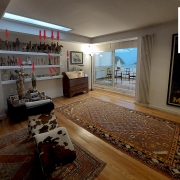ASIAN ART AUCTION 29 DECEMBER 2022
Pair of Sancai glazed pottery bowls, Tang dynasty (618 - 906)
Press 'Program an autobid'in order to confirm
Plates modelled in kaolin ware and decorated in amber, green and cream-coloured 'sancai' glaze (三彩).
Both dishes have a circular profile with a smooth rim and relief decoration on the inside, divided into bands. The shape is on a circular base. The inner rim is rounded and covered by a border, framed by rings, formed by leaves. It is surrounded by a central circle, segmented by a square with concave sides, an inset central flower and spandrels that hold curled leaves. The decorative details on the ceramic are well modelled.
A 'sancai' glaze has been applied to the piece, which ends before reaching the base, revealing a light-coloured, reddish paste. It covers the different elements in relief in amber, green and cream, although it expands in most cases. Three 'atifle marks' can be seen on the inside. This may indicate that the firing was carried out upside down, as evidenced by the way the shades of the glaze flow.
Although the lower decoration is similar, the result is never the same. During firing, when the glaze slips, it is randomly mixed. The craftsman's skill, together with the randomness of the firing, is essential to obtain a harmonious design. The choice of colours brings originality to the design.
Height: 3.8 cm; diameter of mouth: 12.70 cm.
It is in an exceptional state of preservation, considering its age. One of the dishes has a volumetric reintegration on the base.
Provenance:
Spanish private collection.
This important private collection comes from a successful businessman dedicated to national and international construction and investment who lived in different parts of Spain and the South of France. This part of the collection, exhibited exclusively for the first time at auction, focuses on Chinese ceramics from the Tang dynasty and is a collection of museum quality pieces. The family's tradition of travel dates back to the success of an ancestor who in the 1930s travelled to Manila, Shanghai, Cairo, Havana, etc., practising the sport of "cesta punta", and in particular, motivated by an interest in discovering different cultures, which led them to build up a large collection. In general, their interest in art is such that their collection includes pieces of both Asian and European origin.
The acquisition of the collection began in the 1990s and was built up during years of study in Madrid and on various trips to Paris, New York, Hong Kong, Spain and Germany; at reputable antique dealers such as "Arch Angel" in Hong Kong and international auctions such as Nagel. To this end, specialists have also collaborated in the selection, study and verification of the pieces, as can be seen in the accompanying documentation: invoices, studies and reports.
Further information:
These ceramic forms, dedicated to being in funerary trousseaus, were produced during the Tang dynasty. This period is considered to be a golden age for art, culture and the discovery of artistic techniques in China. It is at this time that porcelains decorated with a three-colour "sancai" glaze were developed. It is for this reason that these ceramics are valued and appreciated today over the centuries.
Moulded pottery vessels or utensils with added colour during the Tang Dynasty are notable for their high quality and unique and complex production process. The production process was complex for 7th- and 8th-century potters: the moulds are fired in kilns at around 1100 °C, then the glaze is applied and finally the temperature is lowered to 900 °C for firing the decoration.
























